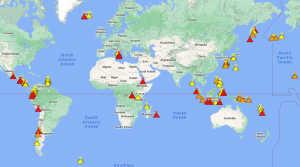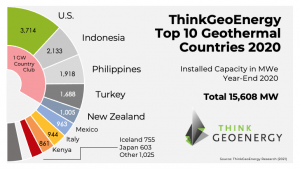A number of countries are considering using volcanoes to generate electricity, potentially providing cheaper and greener energy to local Bitcoin (BTC) mining operations while China is cracking down on this industry. In Latin America and the Caribbean alone, some 3,000 volcanoes could be used for this purpose.
Yesterday, El Salvador’s President Nayib Bukele unveiled plans by his country to use geothermal energy from volcanoes to mine BTC, saying that a state-owned company could provide mining facilities with affordable and green energy.
Our engineers just informed me that they dug a new well, that will provide approximately 95MW of 100% clean, 0 emis… https://t.co/Wx41GE474M
The country’s embrace of bitcoin as legal tender and its president’s project to use volcanoes to boost the country’s crypto mining operations are based on existing developments in other parts of the world.
In Iceland, magma-fuelled power plants have been providing the country with enough energy to power BTC mining facilities whose energy use had exceeded that of Icelandic households as early as 2018, as reported by The Guardian at the time.
In Central and South America, numerous countries could follow Iceland’s example owing to the region’s unique geographic qualities, according to local industry observers.
“We have more than 3,000 volcanoes all over Latin America and the Caribbean,” Christiaan Gischler Blanco, an energy specialist at the Inter-American Development Bank (IDB), told US radio program The World last month. “So you can imagine that there is a lot of energy there, and we could definitely harness much more.”
This interactive map of active volcanoes across the world confirms a number of Latin American and Caribbean countries host untapped energy resources that could be used to mine crypto. These include Mexico, Costa Rica, Guatemala, Honduras, Nicaragua, Colombia, Ecuador, Peru, and Chile, among others.

Geothermal energy exists in some 90 countries across the world, but only 24 of them produce electricity from geothermal sources, according to 2016 figures from the United Nations Economic Commission for Europe (UNECE).
In 2020, the US hosted the largest concentration of geothermal production, followed by Indonesia, the Philippines, Turkey, New Zealand, Mexico, Italy, and Iceland, as indicated by data from specialist publication NS Energy.

The recent crackdown on coal-powered Chinese mining facilities and worries about bitcoin’s carbon footprint could provide a strong incentive for volcano energy’s allocation to crypto mining, paired with an increased drive to carbon-neutral bitcoin investing by funds such as One River Digital Asset Management. The firm said it has created an option for its institutional investors to invest in digital strategies while offsetting the carbon emissions of crypto mining.
However, per the National Geographic, geothermal energy doesn’t come without its own environmental problems, mainly the release of hydrogen sulfide gas and the disposal of some geothermal fluids, which may contain low levels of toxic materials.
____
Learn more:
– Moving to Green Bitcoin May be Moving To a Two-Tier Bitcoin
– Green Investments Help Bitcoin Miners Amid Possible Regulatory Crackdown
– Proof-Of-Bitcoin Needed As Critics & Competitors Unite To Play Climate Card
– A Closer Look at the Environmental Impact of Bitcoin Mining
– Rainy Season Will Test Just How Watertight China’s Bitcoin Mining Ban Is
– Rainy Season Will Test Just How Watertight China’s Bitcoin Mining Ban Is
Credit: Source link












































































































































